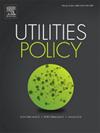Dynamics and regional heterogeneity in the generation efficiency of Japan's photovoltaic power plants focusing on new market entrants
IF 3.8
3区 经济学
Q3 ENERGY & FUELS
引用次数: 0
Abstract
The installation capacity of photovoltaic (PV) power generation systems in Japan in 2022 was 84 GW. Furthermore, 26.2 GW of PV power generation systems are expected to be newly installed by 2030, which indicates there will be several new entrants into the PV power generation market in the near future. We applied data envelopment analysis and the metafrontier global Malmquist index (MGMI) to Japan's PV power generation plant data (2016–2020) to investigate the static power generation efficiency and its growth considering new entrants and regional heterogeneity. The results demonstrated that the western region showed the highest static efficiency. Conversely, the eastern region experienced the largest increase in MGMI, with an average annual growth rate of 1.2 %. The decomposition analysis results of MGMI reveal that technological innovation within the same region is the primary driver of the growth in MGMI in all regions, while the catch-up effect has a negative effect. These results indicate that while advanced PV power plants in all regions contribute to advancing frontier technologies, others are insufficiently catching up. Policymakers should, therefore, encourage technology spillover between innovative power plants and others to promote the catch-up effect. We additionally identified innovative power plants that promote frontier technology, and the results demonstrated that plants that started operation before 2016 primarily contributed to technological innovation, indicating that the learning-by-doing effect of existing plants and the availability of favorable sites have a greater impact on power generation efficiency than introducing advanced facilities.
日本光伏电站发电效率的动态和地区异质性,重点关注新市场进入者
2022年,日本光伏发电系统的装机容量为84吉瓦。此外,到2030年,预计将新安装26.2 GW的光伏发电系统,这表明在不久的将来将有几家新进入光伏发电市场。本文采用数据包膜分析和met前沿全球Malmquist指数(MGMI)对日本光伏电站数据(2016-2020年)进行分析,研究了考虑新进入者和区域异质性的静态发电效率及其增长。结果表明,西部地区的静态效率最高。相反,东部地区的MGMI增幅最大,年均增长率为1.2%。区域内技术创新是区域内技术创新增长的主要驱动力,赶超效应对区域内技术创新增长具有负向影响。这些结果表明,虽然所有地区的先进光伏电站都对前沿技术的发展做出了贡献,但其他地区的追赶程度还不够。因此,政策制定者应该鼓励创新电厂和其他电厂之间的技术溢出,以促进追赶效应。我们还确定了推广前沿技术的创新型电厂,结果表明,2016年之前开始运营的电厂主要对技术创新做出了贡献,这表明现有电厂的边做边学效应和有利地点的可用性比引进先进设施对发电效率的影响更大。
本文章由计算机程序翻译,如有差异,请以英文原文为准。
求助全文
约1分钟内获得全文
求助全文
来源期刊

Utilities Policy
ENERGY & FUELS-ENVIRONMENTAL SCIENCES
CiteScore
6.80
自引率
10.00%
发文量
94
审稿时长
66 days
期刊介绍:
Utilities Policy is deliberately international, interdisciplinary, and intersectoral. Articles address utility trends and issues in both developed and developing economies. Authors and reviewers come from various disciplines, including economics, political science, sociology, law, finance, accounting, management, and engineering. Areas of focus include the utility and network industries providing essential electricity, natural gas, water and wastewater, solid waste, communications, broadband, postal, and public transportation services.
Utilities Policy invites submissions that apply various quantitative and qualitative methods. Contributions are welcome from both established and emerging scholars as well as accomplished practitioners. Interdisciplinary, comparative, and applied works are encouraged. Submissions to the journal should have a clear focus on governance, performance, and/or analysis of public utilities with an aim toward informing the policymaking process and providing recommendations as appropriate. Relevant topics and issues include but are not limited to industry structures and ownership, market design and dynamics, economic development, resource planning, system modeling, accounting and finance, infrastructure investment, supply and demand efficiency, strategic management and productivity, network operations and integration, supply chains, adaptation and flexibility, service-quality standards, benchmarking and metrics, benefit-cost analysis, behavior and incentives, pricing and demand response, economic and environmental regulation, regulatory performance and impact, restructuring and deregulation, and policy institutions.
 求助内容:
求助内容: 应助结果提醒方式:
应助结果提醒方式:


